

Let’s Play 'Get to Know Your Syllabus' - NISOD. How to Improve Your Teaching With the Course Syllabus. Did you ever have a student misunderstand an assignment, express surprise that you had considered attendance important, or want an explanation of how you grade after the final exam has been scored and the semester is over?
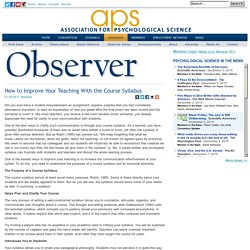
If, like most teachers, you receive a few such remarks every semester, you already appreciate the need for clarity in your communication with students. One of the best ways to clarify such communication is through your course syllabus. As a teacher, you have probably distributed thousands of them and no doubt have written a score or more, yet often the syllabus is given little serious attention. But as Rubin (1985) has pointed out, “We keep forgetting that what we know—about our disciplines, about our goals, about our teaching—is not known (or agreed upon) by everyone. We seem to assume that our colleagues and our students will intuitively be able to reconstruct that creature we see in our mind’s eye from the few bones we give them in the syllabus” (p. 56). Professors, Students, and the Syllabus. (This article first appeared in the Graduate Teacher Program Handbook.
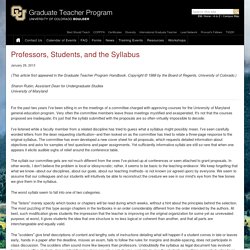
Copyright © 1988 by the Board of Regents, University of Colorado.) Sharon Rubin, Assistant Dean for Undergraduate Studies University of Maryland For the past two years I've been sitting in on the meetings of a committee charged with approving courses for the University of Maryland general-education program. Very often the committee members leave those meetings mystified and exasperated.
It's not that the courses proposed are inadequate; it's just that the syllabi submitted with the proposals are so often virtually impossible to decode. Purposes of a Syllabus, Center for Innovation in Teaching and Learning, University of Illinois. Syllabi seem to vary in two fundamental areas—the apparent reason for writing the syllabus and the material that it contains.

The purpose of the syllabus should drive the decision as to what content to include (Parkes & Harris, 2002). A Syllabus Tip: Embed Big Questions. April 16, 2012.

Syllabus cline article 2. Syllabus Joke. UDL-Universe: A Comprehensive Universal Design for Learning Faculty Development Guide - In addition to advocating innovative instruction and multiple modes of representation, engagement, and expression, UDL encourages the use of “accessible” and “usable” course materials.

These are documents saved in electronic formats (e.g., doc, rtf, pdf, html) and formatted to enhance their usability for the largest possible audience. A single presentation method can prove limiting, for example, when providing a course syllabus. Since a print copy can only be used in one mode (that is to say, it must be seen to be read), it is inaccessible to students who possess visual impairments. The same syllabus, however, saved in an electronic format, can be read aloud by screen reader software and translated into Braille, which can in turn be printed or read at the computer using a refreshable Braille keyboard (available at many campuses). The same electronic version can be posted on the web to help students who have simply misplaced their copy. Accessible Images Accessible Text Audio Video. UDL Syllabus Rubric UPDATED 2 9 2012. Syllabus evaluation rubric ctk2014. How to Improve Your Teaching With the Course Syllabus.
Creating ← The Graphic Syllabus. Graphic Syllabi Structures Now that you have collected and categorized your course syllabus components, it’s time to get creative and start sketching your graphic syllabus!
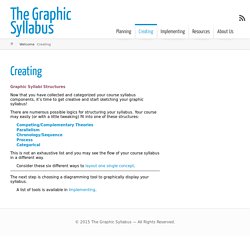
There are numerous possible logics for structuring your syllabus. Your course may easily (or with a little tweaking) fit into one of these structures: This is not an exhaustive list and you may see the flow of your course syllabus in a different way. Consider these six different ways to layout one single concept. Planning a Class with Backward Design. It’s easy to switch into automatic pilot mode when it comes to planning a course.
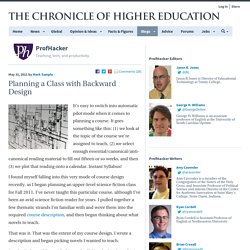
It goes something like this: (1) we look at the topic of the course we’re assigned to teach, (2) we select enough essential/canonical/anti-canonical reading material to fill out fifteen or so weeks, and then (3) we plot that reading onto a calendar. Instant Syllabus! I found myself falling into this very mode of course design recently, as I began planning an upper-level science fiction class for Fall 2011. I’ve never taught this particular course, although I’ve been an avid science fiction reader for years. I pulled together a few thematic strands I’m familiar with and wove them into the required course description, and then began thinking about what novels to teach. That was it.
David Foster Wallace’s mind-blowing creative nonfiction syllabus: “This does not mean an essayist’s goal is to ‘share’ or ‘express herself’ or whatever feel-good term you got taught in high school” English 183D is a workshop course in creative nonfiction, which term denotes a broad category of prose works such as personal essays and memoirs, profiles, nature and travel writing, narrative essays, observational or descriptive essays, general-interest technical writing, argumentative or idea-based essays, general-interest criticism, literary journalism, and so on.
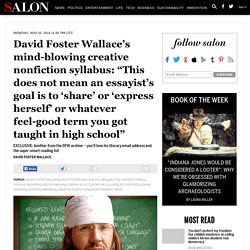
The term’s constituent words suggest a conceptual axis on which these sorts of prose works lie. As nonfiction, the works are connected to actual states of affairs in the world, are “true” to some reliable extent. If, for example, a certain event is alleged to have occurred, it must really have occurred; if a proposition is asserted, the reader expects some proof of (or argument for) its accuracy. At the same time, the adjective creative signifies that some goal(s) other than sheer truthfulness motivates the writer and informs her work.
Expenses. Creating a Syllabus. Below you will find some helpful information and resources to use when creating your syllabus.
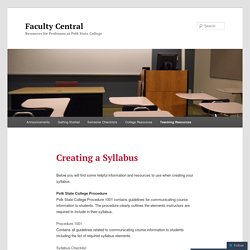
Polk State College Procedure Polk State College Procedure 1001 contains guidelines for communicating course information to students. The procedure clearly outlines the elements instructors are required to include in their syllabus. Procedure 1001 Contains all guidelines related to communicating course information to students including the list of required syllabus elements.
Syllabus Design. Center for Teaching Advancement and Assessment Research Phone: (848) 932-7466 Fax: (732) 932-1845Directions All Rutgers faculty and instructors are expected to develop a comprehensive and detailed course syllabus for each course.
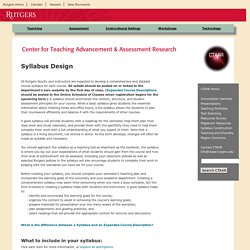
All syllabi should be posted on or linked to the department's own website by the first day of class. (Expanded Course Descriptions should be posted to the Online Schedule of Classes when registration begins for the upcoming term.) A syllabus should summarize the content, structure, and student assessment principles for your course. A good syllabus will provide students with a roadmap for the semester, help them plan their class work and study calendars, and provide them with the specificity they need to help them complete their work with a full understanding of what you expect of them. Getting students to read the syllabus with a Syllabus Quiz - GeoEd Trek.
I would like to start with a true story… one semester, a faculty member finds an assignment turned in by a student matches word-for-word an assignment from another student. That faculty member follows her institution’s procedures for suspecting a violation of academic integrity – having a conversation with the student, submitting a report to the academic integrity committee, etc., etc. The student protests the charge of cheating, and a hearing is held with the committee, student and faculty member.
The committee asks the faculty member if she included the university academic integrity policy in the syllabus, as required by the university. She answers yes. Getting Students to Read the Class Syllabus. Idea_Paper_27. Extreme Makeover, Syllabus Edition. There’s chatter today among some of my digital humanities folks about creating swizzly digital CVs: see for example one of the gurus of Digital Campus, Found History‘s Tom Scheinfeldt’s post from last May, “New Wine in Old Skins: Why the CV Needs Hacking,” followed by Adam Crymble’s borderline-smug post today, “My CV is Better Than Yours.”
I suppose this website is something like a CV, if you bother to click between the “Writing” and “Projects” pages, but I’ve no desire to emulate Crymble’s faux-newsletter design – it would (alas) probably be considered simply gimmicky in my neck of the woods. 112.Spr11. The First Day Wiki. How Did This Happen? Never thought I’d append “wiki” to a post, but here we are. Here, approaching the dead center of August, I’m getting Google hits along the lines of “first day geometry lesson” and I don’t have content to show for it. So I’m posting some of my first day procedures, which are by no means authoritative.
The comments section of this post seems an inadequate container for all the first-day wisdom you all have, so I’m going to encourage you to add on to The First Day Wiki. Syllabus Ideas, Syllabus Template and Class Syllabus. Creative Approaches to the Syllabus. There’s no denying that syllabus bloat is a real phenomenon. Every semester, it seems, there’s a push to put more and more in the syllabus. And there’s no denying that it can sometimes be useful to treat the syllabus as a meaningful resource for the whole semester. However, as Barbara Fister complained at Library Babel Fish this morning (via Mary Churchill), the syllabus is increasingly seen not as a resource, but something everyone skips without reading–Terms of Service agreements : When you add all those rules to the traditional stuff – course description, the list of assigned texts, the class-by-class schedule, and information about major assignments – these documents get incredibly long and complex. . . .
NspireD2: Learning Technology in Higher Ed. Erin McLaughlin teaches “Multimedia Writing and Rhetoric” at Notre Dame — some readers may remember an earlier article about Doctor E’s audio narrative. Erin is usually at the head of the pack when it comes to effectively integrating technology and this fall she has done it again, producing a beautiful infographic of her course syllabus (excerpt at right). Bring It to Class. Ideas for Class Lessons Marx and the University (an excerpt from The Communist Manifesto with discussion questions related to the corporatization of the university and adjuncting) Confessions of a Community College Dean: Ask the Administrator: Standard Syllabi.
CUNY adjuncts ask not to be called professors in course syllabuses to highlight working conditions. Purposes of a Syllabus, Center for Innovation in Teaching and Learning, University of Illinois. Dr. Write: Misconceptions about the Syllabus. Syllabus Construction. Print Version. College course syllabi: They’re too long, and they’re a symbol of the decline and fall of American higher ed. Illustration by Alex Eben Meyer When I was an undergrad in the ’90s, there was little more exciting than the first day of class. Zeitguest: Don’t cover the syllabus, UNCOVER it… by David Mearns. I’m delighted to be host to this fantastic guest post by David Mearns, a fellow English teacher here in Istanbul.
I first met David more than a decade ago and have always been amazed by the energy and enthusiasm he has for this job. Enjoy… Sociology: Social Problems - Visual Syllabus 2012. Syllabus. Characteristics of a Good Syllabus. Untitled Document. Building a Learner Centered Syllabus by Kristina Kauffman I was fortunate to have many wonderful professors during my undergraduate years, but I do not recall receiving a syllabus that contained much more than the name of the class, contact information for the professor, the text, reading assignments and lecture topics. Creating Your Syllabus. Creating A Syllabus. Writing a Syllabus. The Syllabus.